Prospect Camp, Bermuda
| Prospect Camp | |
|---|---|
| Devonshire Parish,Bermuda | |
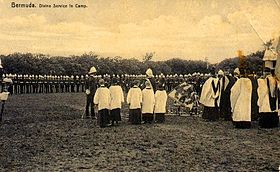 Presentation of colours at Prospect Camp recreation ground (now the Bermuda National Stadium) | |
| Coordinates | 32°17′58″N64°45′55″W/ 32.2994949°N 64.7653454°W |
| Type | Barracks |
| Site information | |
| Owner | Ministry of Defence |
| Operator | |
| Site history | |
| Built | circa 1850 |
| In use | 1850s–1957 |
| Garrison information | |
| Garrison | Bermuda Garrison |
Prospect Camp,also referred to asProspect Garrison,was the main infantry camp of theBermuda Garrison,the military force stationed in theImperial fortressofBermuda.It also containedFort Prospect,Fort Langton,andFort Hamilton,as well as being the base for mobile artillery batteries, manned by theRoyal Artillery(from 1899 to 1924, theRoyal Garrison Artillery). Outlying parts of the camp were disposed of in the early decades of the Twentieth Century as the garrison in Bermuda was reduced. The core area, including the barracks, passed to the local government when the garrison was withdrawn in 1957.[1]
History[edit]
Military in Bermuda prior to the development of Prospect Camp[edit]
The Bermuda Garrison was built up from the 1790s onwards, paralleling the development of theRoyal Navyfacilities in Bermuda. Following US independence, which cost the Royal Navy all of its continental bases between theMaritimesandFlorida(the latter of which would also pass to the United States), Bermuda, located 640 miles offCape Hatteras,North Carolina,became very important to the Royal Navy, which began buying up tracts of land around the colony. Although the West End had been identified immediately as the ideal location for a dockyard and naval base, no passage through the encircling reefs large enough to allowships-of-the-lineto access the West End, theGreat Sound,andHamilton Harbourwas then known. The navy spent a dozen years charting the reefs around Bermuda in search of a passage. Meanwhile, it concentrated its establishment inSt. George's Harbour,buying land in and aroundSt. George's Town.[2]The regular army'sBermuda Garrisonwas built-up along with the naval establishment, both to defend Bermuda as a naval base, and to work with the navy in carrying out amphibious warfare on theAtlantic seaboardin any potential war with the United States, as demonstrated during theAmerican War of 1812.[3][4][5][6][7]
With most of the military fortifications built previously by the militia already clustered around the East End, as well, theBritish Armybuilt up a large garrison, with headquarters and barracks, to the north of the town. Many forts, batteries and other smaller sites were scattered about Bermuda, but most of the army's manpower was inSt. George's Garrison.[8]
Development of the camp[edit]
By 1812, the navy was developing the newRoyal Navy Dockyardat the West End, onIreland Island.The new town ofHamilton,located in the central parishes, and to which the colony's capital moved from St. George's in 1815, was achieving increasing prominence as an Imperial fortress thanks to the same channel which allowed development of the dockyard. It became necessary to redeploy much of the military force in Bermuda westward, nearer to the new capital and the dockyard. Consequently, in the middle of the 19th century, the army purchased land on White Hill in Devonshire, and began the development of a large camp, with barracks to house the bulk of the infantry soldiers in Bermuda. Called Prospect Camp, it contained the headquarters of Bermuda's military garrison, barracks, parade grounds, training areas, and a fort. Prospect Fort was manned by the garrison units of theRoyal Regiment of Artillery,later known as theRoyal Garrison Artillery(this was one of three forts whosecoastal artillerywas intended to complement each other's with overlapping fire to guard the shores and the overland approaches to Hamilton, the others being Fort Hamilton and Fort Langton).[9][10][11]
Although Prospect Camp had extensive areas for training, it was surrounded by public roads and residential areas, and had no safe area for a rifle range. Consequently, a second camp,Warwick Camp,was added primarily to provide rifle ranges to the soldiers of the garrison, and the dockyard's ownRoyal Marinedetachment (and those of the ships stationed there). Warwick Camp had no units permanently assigned to it, however, with different units deploying there specifically for periods of training. Various other smaller sites were used by the Army over the history of the garrison. These included Watford Island and Boaz Island, both part of the Admiralty land holdings attached to the HM Dockyard, where Clarence Barracks had been erected to re-house convicts labourers (sent to Bermuda to take part in the construction of the Royal Naval Dockyard) previously accommodated onprison hulks.After the last convicts were removed from Bermuda in the 1860s, Boaz and Watford Islands were transferred to the army and housed a considerable number of soldiers (there being capacity for a battalion of infantry plus detachments from other corps).[12]Bermuda was divided into three military districts, centred (from West to East) on Clarence Barracks, Prospect Camp, and St. George's Garrison, with overall Command Headquarters at Prospect Camp.
Use of the camp[edit]

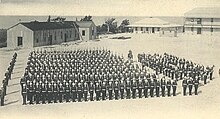
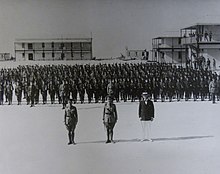
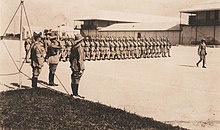
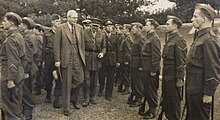
Through much of the 19th century, a fullbattalionof infantry soldiers was based in Bermuda, along with various artillery, engineer, and other support units. By the 1860s, financial constraints, the intention to redeploy more of the British Army in Britain to guard against invasion, and the intention to compose what would come to be known as theBritish Expeditionary Force(BEF), meant the garrison in Bermuda was scheduled for reduction. With Bermuda remaining an important naval base, however, the regular soldiers were obliged to remain in full strength for many years, until thegovernment of Bermudacould be induced to raise part-time units, theBermuda Militia Artilleryand theBermuda Volunteer Rifle Corps,to take on part of the responsibilities of the garrison. From then on, the regular soldiers in Bermuda were slowly whittled away. Between the two world wars, the regularRoyal ArtilleryandRoyal Engineerswere withdrawn completely, handing their responsibilities entirely to the BMA and theBermuda Volunteer Engineers.Although regular infantry soldiers remained, Bermuda no longer had a full garrison, and only a detached company was posted to Prospect Camp. As a new battalion deployed to Jamaica, it detached a company in Bermuda along the way.
During theSecond World War,in addition to housing the headquarters and the regular infantry, the camp was also used for training overseas contingents from the part-time units (which had been embodied on a full-time basis for the duration of the war). The First Contingent of the BVRC, which left Bermuda to join theLincolnshire Regimentin England, trained at Prospect Camp, along with several volunteers from the BMA and BVE who travelled with them to England, before detaching to join their larger corps. In 1943 Prospect Camp housed the Training Battalion, a temporary force composed of volunteers from the BVRC, the BMA and theBermuda Militia Infantry,to train for deployment overseas. The battalion then split into two contingents; the Second Contingent of the BVRC which joined the Lincolnshire Regiment in Britain, and the Bermuda Militia contribution to the newCaribbean Regiment,for which it provided the Training Cadre, which was raised in North Carolina.[14]
Withdrawal of garrison and closure of the camp[edit]

In 1951 it was announced that the Royal Navy's dockyard would be closed, a process that stretched throughout the 1950s, and left only a reduced resupply base, HMS Malabar, which operated until 1995. Without the dockyard, and with large naval and air bases of NATO ally, the USA, located in Bermuda, the military garrison became unnecessary. The last Imperial Defence Plan was issued in 1953. After that, the localpart-time unitsceased to have any role assigned by theWar Office(or its successor, theMinistry of Defence). The last regular detachment, a company of theDuke of Cornwall's Light Infantry(DCLI), was withdrawn in 1957, following which Prospect Camp, along with most of the military and admiralty properties in Bermuda were transferred to the local government for £750,000.
Post-military usage[edit]
Following its transfer to the local government, Prospect Camp has been split between a number of government departments and private owners. TheBermuda Police Servicehas been the primary occupant, housing its headquarters, barracks, and various sub-units there. The Department of Education has also made considerable use of former camp grounds, having housed Prospect Secondary School in former barracks buildings, and having originally sited the campus of the Bermuda College there. In the 1990s, several barracks and other buildings were levelled, and the new Cedarbridge Academy was built in their place. TheNational Stadiumalso occupies part of the former military camp.
References[edit]
- ^Young, Douglas MacMurray (1961).The Colonial Office in The Early Nineteenth Century.London: Published for the Royal Commonwealth Society by Longmans. p. 55.
- ^"St Georges Harbor Bermuda".Bermuda Attractions.Retrieved17 August2014.
- ^Harris, Dr. Edward Cecil (21 January 2012)."Bermuda's role in the Sack of Washington".The Royal Gazette.City of Hamilton, Pembroke, Bermuda.Retrieved8 August2021.
- ^Grove, Tim (22 January 2021)."Fighting The Power".Chesapeake Bay Magazine.Annapolis: Chesapeake Bay Media, LLC.Retrieved8 August2021.
- ^Kennedy, R.N., Captain W. R. (1 July 1885). "An Unknown Colony: Sport, Travel and Adventure in Newfoundland and the West Indies".Blackwood's Edinburgh Magazine.William Blackwood & Sons, Edinburgh, Scotland, and 37 Paternoster Row, London, England. p. 111.
As a fortress, Bermuda is of the first importance. It is situated almost exactly half-way between the northern and the southern naval stations; while nature has made it practically impregnable. The only approach lies through that labyrinth of reefs and narrow channels which Captain Kennedy has described. The local pilots are sworn to secrecy; and, what is more reassuring, by lifting buoys and laying down torpedoes, hostile vessels trying to thread the passage must come to inevitable grief, So far Bermuda may be considered safe, whatever may be the condition of the fortifications and the cannon in the batteries. Yet the universal neglect of our colonial defences is apparent in the fact that no telegraphic communication has hitherto been established with the West Indies on the one side, or with the Dominion of Canada on the other.
- ^VERAX, (anonymous) (1 May 1889). "The Defense of Canada. (From Colburn's United Service Magazine)".The United Service: A Quarterly Review of Military and Naval Affairs.LR Hamersly & Co., 1510 Chestnut Street, Philadelphia, Pennsylvania, USA; subsequently LR Hamersly, 49 Wall Street, New York City, New York, USA; BF Stevens & Brown, 4 Trafalgar Square, London, England. p. 552.
The objectives for America are clearly marked,—Halifax, Quebec, Mon- treal, Prescott, Kingston, Ottawa, Toronto, Winnipeg, and Vancouver. Halifax and Vancouver are certain to be most energetically attacked, for they will be the naval bases, besides Bermuda, from which England would carry on her naval attack on the American coasts and commerce.
- ^Dawson, George M.; Sutherland, Alexander (1898).MacMillan's Geographical Series: Elementary Geography of the British Colonies.London: MacMillan and Co., Limited, London, England, UK; The MacMillan Company, New York City, New York, USA. p. 184.
There is a strongly fortified dockyard, and the defensive works, together with the intricate character of the approaches to the harbour, render the islands an almost impregnable fortress. Bermuda is governed as a Crown colony by a Governor who is also Commander-in-Chief, assisted by an appointed Executive Council and a representative House of Assembly.
- ^"Historic Town of St George and Related Fortifications, Bermuda".UNESCO.Retrieved17 August2014.
- ^WillockUSMC,Lieutenant-Colonel Roger (1988).Bulwark Of Empire: Bermuda's Fortified Naval Base 1860–1920.Bermuda: The Bermuda Maritime Museum Press.ISBN9780921560005.
- ^Gordon, Donald Craigie (1965).The Dominion Partnership in Imperial Defense, 1870-1914.Baltimore, Maryland, USA: Johns Hopkins Press. p. 14.
There were more than 44,000 troops stationed overseas in colonial garrisons, and slightly more than half of these were in imperial fortresses: in the Mediterranean, Bermuda, Halifax, St. Helena, and Mauritius. The rest of the forces were in colonies proper, with a heavy concentration in New Zealand and South Africa. The imperial government paid approximately £1,715,000 per annum toward the maintenance of these forces, and the various colonial governments contributed £370,000, the largest amounts coming from Ceylon and Victoria in Australia.
- ^MacFarlane, Thomas (1891).Within the Empire; An Essay on Imperial Federation.Ottawa: James Hope & Co., Ottawa, Ontario, Canada. p. 29.
Besides the Imperial fortress of Malta, Gibraltar, Halifax and Bermuda it has to maintain and arm coaling stations and forts at Siena Leone, St. Helena, Simons Bay (at the Cape of Good Hope), Trincomalee, Jamaica and Port Castries (in the island of Santa Lucia).
- ^"TACA Correspondence: British Army birth, marriage and burial records in Bermuda".History Matters.Retrieved17 August2014.
- ^"SECRETARY FOR COLONIES VISITS TRAINING CENTRE".The Royal Gazette.City of Hamilton, Pembroke, Bermuda. 1 January 1945. p. 2.
Colonel the Right Hon. Oliver Stanley, Secretary of State for the Colonies, visitedWarwick Batteryon Saturday morning where he inspected the Vocational Training Centre. Accompanied by Mr T.I.K. Lloyd, an Assistant Under-Secretary of State at the Colonial Office, by his private secretary, Mr. C. H. Thornley, and by Brigadier the Hon. H. D. Maconochie, Officer Commanding British Troops, Colonel Stanley inspected a guard of honour commanded by Captain A. L. Flitcroft, Adjutant,Bermuda Militia.Shortly after 1 o'clock. Colonel Stanley and his entourage arrived at Prospect where they were greeted by Brigadier Maconochie and Lieut.-Col. J. C. Astwood, O.C, B.V.R.C Colonel Stanley inspected a guard of honour provided by the B.V.R.C. under the command of Captain W. J. Williams, following which he visited the Garrison Officers' Mess where he was introduced to the Officers of the Bermuda Command and refreshments wen served. The Colonial Secretary's visit to Prospect marked the first formal parade attended by the newly reorganised B.V.R.C. Band.
- ^"Bermuda's losses in the Second World War".Royal Gazette. 23 October 2010.Retrieved17 August2014.

